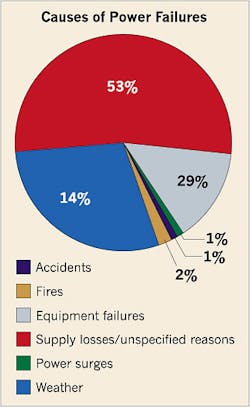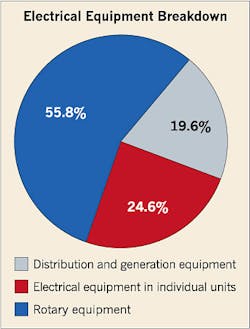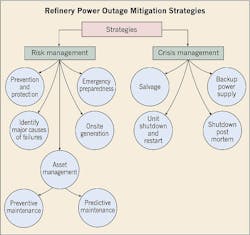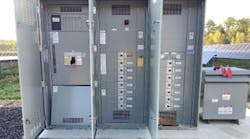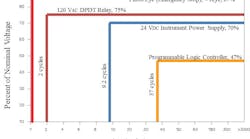Power supply disruptions and electrical equipment failures represented more than 80% of electrical problems in refineries between 2009 and 2013, according to the U.S. Department of Energy. And the electrical problems themselves accounted for one-fifth of all refinery disruptions during this time period. Power outages, mechanical breakdowns, leaks, and fires constituted the majority of incidents — any number of which can force a refinery to shut down.
Not surprisingly, Mother Nature sometimes contributes to refinery outages. This past winter is a good example of how the weather can wreak havoc on a refinery. One of the harshest winters on record, record-breaking cold, ice, and snowfall across much of the nation made operating conditions difficult at best. As a result, refineries in several regions of the country suffered unit shutdowns caused by equipment freezing. Marathon’s Detroit refinery lost instrument air disrupting sensors, which forced a few units to go into flaring mode to avoid problems. PBF’s Paulsboro, N.J., refinery lost steam, resulting in the shutdown of multiple units, while Exxon’s Joliet, Ill., refinery, Motiva’s Norco, La., refinery, and Valero’s Memphis, Tenn., refinery all experienced unit stoppages due to the extreme cold.
Impacts of power outages
The repercussions of a refinery power outage reach further than most people realize. The most recognized impact of an outage is the effect on financial performance, as fuel production is halted and refiners suspend deliveries to the market. For instance, Superstorm Sandy forced Phillips 66's Bayway, N.J., refinery to remain offline from Oct. 28, 2013, to Nov. 20, 2013. According to the company, storm-related expenses came to $56 million before tax. This number, however, does not include the lost profits resulting from more than three weeks of halted production. The revenue loss for the period has been estimated in excess of a staggering $650 million.
In addition, power interruptions, which require burning of hydrocarbons through flaring and can cause excessive emissions of pollutants, could prompt environmental concerns by governing authorities and local communities. Subsequent fines and penalties may be levied if the emissions are found excessive and the incidents are deemed avoidable.
Furthermore, a sudden shutdown causes an immediate concern for worker safety. Fatalities or injuries to workers could lead to lawsuits, ultimately resulting in legal liabilities. The goal of improving plant energy efficiency to lower production cost and also reduce carbon footprint would be compromised due to higher energy consumption for restarts. Lastly, negative publicity due to a potential fuel shortage plus possible safety and environmental incidents equals a nightmare for any refiner.
Identify major causes of failures
Knowing the causes of power disruptions can help a refinery devise a plan to mitigate them. Figure 1 illustrates the major causes of power failures in U.S. refineries from 2009 to 2013. As the graphic shows, the majority of power failures are a result of the source power from the electric utility being lost or the feed being lost due to an unknown cause. The second biggest cause of power failures is electrical equipment interruptions. These include transformer failures, switchgear and circuit breaker breakdowns, compressor motors tripping, and more.
In Fig. 2, the distribution of electrical equipment breakdowns from 2009 to 2013 is shown. The majority of power issues are due to rotary equipment trips, which include compressor motors and air blowers tripping. The second leading cause is the refinery processing unit experiencing electrical problems. This is typically listed as “a hydrocracking unit had electrical issues.” The third cause is the failure of distribution and generation equipment, such as a transformer, switchgear, and circuit breaker.
Risk and crisis management
Refinery power outage mitigations are based on two major strategies: risk management and crisis management (see Fig. 3). In handling risk management, a refinery must install the most reliable equipment available that can withstand disruptions caused by weather, power surges, blackouts, and any other outside elements. Because no equipment is perfect, the reliability engineers and operators must prepare for worst-case scenarios as well as the most frequently occurring possibilities. This is where the use of prevention techniques to detect and fix problems before they lead to a power failure becomes most valuable. When a problem arises, the second strategy — crisis management — comes into play. This involves the recovery technologies that allow for safe shutdown and continued operation, and the restart methods that won’t lead to the same problem that caused the previous failure.
How to manage risks in refinery power supply
Prevention and protection — The first step to successfully fight power disruptions is to make sure that the incidents can be prevented. It is also important to have the correct devices to protect electrical equipment from being damaged either by weather, power quality, or outages. In June 2013, Rich Johnson, Phillips 66 spokesman, replied to a Platts inquiry into the aftermath of Superstorm Sandy that his company is considering elevating the electrical equipment in addition to other improvements to the Bayway, N.J., refinery. He added, "At the Linden terminal, we are also constructing and installing critical control buildings and electrical systems above the 100-year floodplain in order to minimize future damage."
Installing protective equipment (such as protective relays, circuit breakers, fuses, grounding, and surge arrestors) is an excellent approach to shielding electric systems and preventing power failure. However, these installed devices are also vulnerable to failure. When not working properly, they cannot protect the rest of the system from dangers such as faults. Therefore, it is important that these devices are top quality and reliable, and that maintenance is routinely performed.
Emergency preparedness — If refineries expect to be prepared in the event of an emergency, proactive procedures such as assessing potential risks, outlining possible emergency scenarios, practicing contingency operations, deploying sufficient system resources, and implementing management and employee training are critical. The use of a mass notification system for every day, non-emergency, intra- and inter-facility communication may also be a crucial asset in alerting workers to the occurrence of an incident and coordinating a proper response by emergency personnel. It can also be used to notify community officials, emergency response agencies, neighboring facilities, and the local community.
Preparation for any type of emergency begins with understanding the threats that exist within a refinery. Any event that could lead to injury, death, environmental damage, or prolonged shutdown must be evaluated. Different methods of process hazard analysis (PHA) are available to assess the urgency of hazards, the severity of these hazards, and the amount of investment that should be allocated to prevent or mitigate these hazards. Well-known methods, such as risk analysis matrix, layers of protection analysis (LOPA), and process safety management (e.g., PSM Metrics, HAZOPs), can be used to plan for hazards as well as help personnel and management visualize and quantify the importance of hazard prevention and mitigation.
Asset management — The focus of maintenance personnel should be on two primary reliability centered maintenance (RCM)-based approaches of maintenance: preventive, which is performed periodically, and predictive, which relies on condition monitoring and data analytics. Critical equipment that has large production losses or safety issues will likely warrant the more complex and sophisticated maintenance strategies like condition-based/predictive maintenance, while less critical equipment will require a time-based/preventive maintenance or run to failure approach. This is where a life-cycle cost analysis (LCCA) comes into play. LCCA evaluates all relevant costs over the time an asset is in use.
Use of wireless devices and instrumentation for data collection in a refinery is on the rise. In a 2011 survey of plant workers from various trades and industries, 68% of those asked preferred wireless data collection and transfer over wired.
Big data is typically defined as a vast, seemingly insurmountable collection of data points. In a refinery, where hundreds — if not thousands — of sensors and monitoring devices for electrical and processing equipment are installed, millions of data points are collected daily. For effective data analysis, certain measures must be taken to effectively manage large data sets, because there are issues related to constraints, overcoming obstacles, cloud data storage, and cyber security.
Enterprise asset management (EAM) is expected to play a major role in the future because the strength of an asset management program relies heavily on the management of all maintenance related data. A predictive maintenance program is only effective if data is collected, stored, protected, analyzed, and distributed properly.
The future of incorporating big data analytics into a maintenance program is the implementation of a prescriptive maintenance approach. Like predictive maintenance, this method will detect failure mechanisms well before an actual failure; however, prescriptive measures can detect future failure and suggest the best course of action to take.
Onsite generation — Refineries can invest in onsite, independent power generation capabilities to help alleviate the problems of power failures. Three onsite power generation technologies for consideration include: combined heat and power (CHP), renewable energy, and microgrids. These units will decrease a refinery’s dependence on the electric utility power supply and allow for continued production when outside power outages occur. Additionally, onsite power generation will help lower electric costs and perhaps even the carbon footprint. Of course, there are challenges associated with the independent power supply in operational and capital costs.
No time for panic
Backup power supply — The main sources of backup power come in battery form or from generators. Generators are used to power the main refining units. Backup generators help get units back online within a specified time, even if they are running at reduced rates. Generators can vary in their capacity and fuel source, with diesel and natural gas-powered units being the most common. Installation and use of backup systems can vary based on the reliability and importance of processing units. In July 2009, the use of a backup generator helped Pasadena Refining’s Pasadena, Texas, complex continue providing feed to a crude unit after a lightning strike caused a tank farm outage.
Uninterruptible power supply (UPS) units are also used to provide backup and maintain a power supply to essential control circuits and instruments during a time of total power failure. The unit’s battery backup power kicks in when it detects a failure to keep all electronics — especially the electronic analog control system it is attached to — running. UPS systems can also improve the quality of the downstream electrical supply by compensating for voltage sags and harmonic distortions.
Unit shut down and restart — In the event of a major shutdown, a refinery must shift from preventive measures to mitigating ones. For events that lead to a loss of power supply to a particular unit (e.g., crude desalter, crude distillation, hydroprocessing, catalytic cracking, alkylation, catalytic reforming, and sulfur plant), certain procedures should be followed that are not only safe, but also result in minimal losses. A refinery’s processing units can be very dangerous if a sudden shutdown occurs, so strict procedures and guidelines must be set to completely shut down specific units. Resultant unit over-pressurization, temperature excursion, and personnel safety are all major concerns.
Units particularly crucial to operation require backup power to temporarily run them while repairs are made or main power is restored. These are the occasions where a refinery must ensure that personnel and nearby areas are safe and out of harm’s way, units have been properly shut down, and resources and crews are allocated for eventual restart.
Shutdown post mortem — After power supply disruptions and electrical equipment failures, it is necessary to find the cause(s) in order to keep history from repeating itself via a technique called root cause failure analysis (RCFA). Knowing the various contributors to equipment failure is important, but being able to trace an individual failure to a specific source or set of sources will prevent future failure to that particular unit and also protect similar units within the refinery. Imperfections in the design, installation, or operation of any asset can be exposed through a thorough analysis of the operating conditions and surrounding influences. RCFAs can effectively improve electrical reliability throughout the refinery because they lead to eliminating any harmful procedures, changing poor operation, educating the staff, modifying design flaws, and reaffirming the functionality of similar or identical equipment. Well-known RCFA methods include Fault Trees, FMEA, and STEP. These can be applied depending on the type of failure and the components and number of components involved.
Conclusion
Every processing unit within an oil refinery was meticulously designed and planned under the assumption that it would receive a constant power supply. With that in mind, it is necessary to consider the steps that could be taken to ensure 24/7 production out of every process. Risk management and crisis management must be practiced to maximize productivity within any plant.
No refinery can afford and tolerate power interruptions, as financial repercussions and potential liabilities due to environmental and safety incidents can cost millions of dollars per day. The responsibility of keeping a smooth operation not only lies with reliability engineers, operation managers, and maintenance personnel, but also with senior management, who should allocate resources to invest in advanced technologies in protection, prevention, and recovery currently available in the market. Refiners are advised to take a holistic approach to managing risks and crises in terms of mitigating power failures. Otherwise, stockholders, communities nearby the refineries, and consumers are paying the price.
Note: This article is an excerpt from the multi-client strategic report “Refinery Power Outage Mitigations: Latest Technologies and Strategies to Minimize Financial Impacts,” by Hydrocarbon Publishing Co., that was issued in February 2014. Special thanks to Baldwin A. Yeung, P.E. of Leidos for providing technical assistance.
Christensen is a project manager. Graf is a technology analyst. Vukovich is a technology analyst. Yeung is principal and managing consultant. All four can be contacted at [email protected].

